___________________
Humanoid NPC's (Bandits, Necromancers)
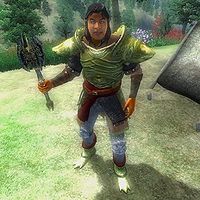
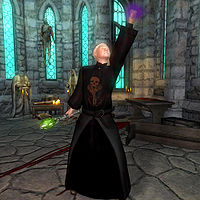
I don't really have much to say here -- but humanoid NPC enemies make a pretty significant amount of Oblivion's enemy population as the daedra and the other random animals and beasts living in Cyrodiil. They're neat, and certainly necessary to actually give antagonists that are, y'know, actual antagonists as opposed to just wild animals. But for the majority, a good chunk of them just fall into basically the same sort of enemies. Bandits and the necromancers of the Worm Cult tend to comprise probably the largest proportion of non-unique humanoid NPC enemies, I think.
Anyway, I'm not dissing these NPC enemies. They're very important for the feel of the game and as antagonists in questlines and stories, but without actually delving into specific characters and storylines, I really don't have much to say about the humanoids.
Scamp
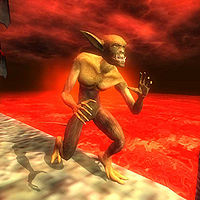
And now we go straight into the Daedra! The Daedra are basically reduced to basically just Atronachs and Dremora come Skyrim, but in Oblivion they are the main antagonists of the setting, so they make up a vast, vast amount of the enemies you're going to face, especially in regards to the main questline. And it's maybe why so many of the other enemies feel kind of mundane -- it's to contrast against the far more... demonic and exotic-looking Daedra.
The absolute weakest of the Daedra are the Scamps. Two main variants exist, the weaker Stunted Scamps, the regular Scamps. The Scamps basically fill in the role that most other games attribute to "imps" -- they're the archetypal little, goblin-like demons that don't seem to have much intelligence, and just look brutish and mischievous. To play with the whole demonic theme, the Scamps attack by either whacking you with their arms, or by launching fireballs.
In general, the Daedra are really inhabitants of other realms and dimensions, and are unable to come into Tamriel/Nirn without the aid of summoners... unless they pass through an Oblivion Gate. Now those gates don't normally form due to the cosmology of the world, through a fair amount of intricate rules that involves the God of Time and the royal bloodline of the Septims. I'm not going to go too deep into this, but it's something that the main villains of Oblivion's storyline, the cult of the Mythic Dawn, are attempting to break down. Your character will have to contend with Daedra that have spilled into Cyrodiil, as well as spend a fair amount of time charging into the depths of Oblivion and fight the Daedra on their own realms and close the gateways leading to our realm.
Clannfear
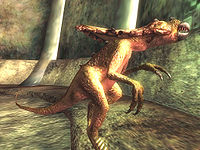
Slightly stronger than the Scamps are the Clannfears, who also come in runt and non-runt variations. And I do like the Clannfears! They have the body of theropodal dinosaurs, but the frill and beaked head of a non-horned Ceratopsian dinosaur, like a Protoceratops or something. It's honestly quite rare to see the token dinosaur in a video game or fantasy setting to not be a T-Rex or Velociraptor.
Anyway, I do like the Clannfears! They're such unexpected choices for 'demons', being just similar enough to a real creature in the living world, while at the same time combining aspects of different ones that just makes them look unsettling enough to look like they don't really belong. Not much to say here, but I do really like them a lot.
Fire Atronach

The Daedra also fill in the role that normal fantasy settings would fill with "elementals", and, well, it sort of plays that at a certain point, the distinction between "extra-dimensional being summoned from another realm" sort of blurs. D&D has very strict rules and cosmology about their elemental planes and the nine realms of hell and all that jazz, but in the world of the Elder Scrolls they're all just "Daedra".
The Flame Atronachs are the fire variant, and they're... they're faceless women made entirely of fire. They're pretty fragile, but tend to attack from afar. It's unfair because my mental image of a Flame Atronach is the far cooler, far more iconic one from Skyrim. That's not to say that Oblivion's Flame Atronach don't work for the limitations of the game, but sometimes a depiction of a creature just really sticks with you, y'know?
Frost Atronach
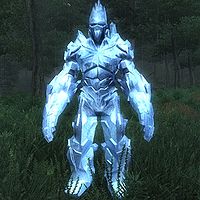
Oblivion's Frost Atronach is also significantly different compared to Skyrim's, although they functionally are based on a similar concept -- big, burly masculine icy humanoid to contrast with the sleek, feminine flame. But where the one in Skyrim looks far more primal and rough-cut, there is something to be loved about Oblivion's Frost Atronach, which actually looks like a gigantic ice sculpture someone carved eyes and musculature onto. Sure, the Frost Atronach still has two glorified clubs for arms, but ultimately, the final result looks far more knightly and a completely different sort of "tough and bulky" compared to Skyrim's walking iceberg. Definitely a fan of this one.
Daedroth
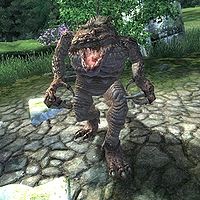
And then you have the Daedroth... which are just giant, walking crocodile-men. Okay, then! Not the most creative of monsters, admittedly, and it is basically what you expect from a humanoid crocodile-man, but it does fit the neat niche of the big, burly enemy among the Daedra ranks. It also spits fireballs, because, well, spitting fire is something that most Daedra apparently just do. Interestingly, and I wouldn't have thought it when I first saw the design, but Daedroths actually begin battle by casting a defensive spell around itself, which is definitely not something I expected from giant crocodile-men. I guess I shouldn't judge. I do have, for whatever reason, a huge love for summoning Daedroths as a meat-shield while playing through Oblivion.
Spider Daedra
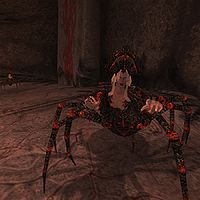
While the Daedroths are the huge meat-tank enemies that are hard to bring down, the Spider Daedra are sort of the 'sneaky' ones that are just a huge pain in the ass to deal with. They're basically Driders from D&D, giant spiders who have the upper body of a woman growing out of where a spider's head should be. Spider Daedras also have some really neat-looking headresses. Despite being based on spiders, though, they jump aoout a whole lot instead of scuttling around (or leaping in a more realistic way that Skyrim's spiders do). It is sort of justified by the fact that they're just demons that look like spiders instead of being actual spiders.
Fighting them is a gigantic pain in the ass, though, because they will summon little copies of herself, Spiderlings, that will paralyze you, which means you just drop immobile for a couple of seconds. It wouldn't be so problematic if you're just fighting a single Spider Daedra, but she tends to have buddies. And sometimes you just fall into a pool of lava. In addition to that, Spider Daedra are able to heal themselves, as well as cast a whole ton of spells that are often more debilitating than damaging.
Anyway, spider ladies are always cool and pretty creepy. Not a whole ton to say beyond that.
Storm Atronach
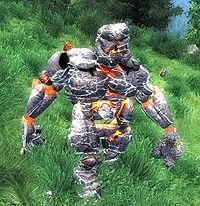
The final and most powerful variant of the Atronach, the Storm Atronach, doesn't show up until relatively later, and they look far, far cooler than they did in Skyrim! They are these long-armed humanoids made entirely of stone held together by electrical energy. Looking at this static picture makes you go "huh. A rock dude. Not impressive"... but in-game, the animations they gave the Storm Atronach is particularly impressive. Instead of walking, the Storm Atranoch moves around by disassembling all of the rocks and spinning around like a little tornado, and when attacking, it will launch part of the rocks that are in his body at you. Far more than the floating rock from Skyrim, Oblivion's Storm Atronachs just really sell the fantasy of a physical manifestation of a storm taking the form of a bunch of rocks that it's holding together.
Xivilai
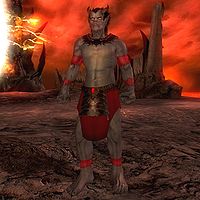
The Xivilai are one of the more powerful versions of the Daedra, and basically the most powerful without going into DLC stuff or the higher-ranked Dreamora. And despite looking humanoid and clearly sentient, they are still classified under the "monster" category, something that's relevant because the type of souls you soul-trap is particularly relevant to charge your magical weapons.
Anyway, I do like the Xivilai. They are these tall humanoids with a loincloth and a neat set of minimalistic demonic jewelry. They tend to be portrayed as powerful spellcasters that like to summon their own Clannfear buddies, while also wielding either powerful fire spells or giant two-handed weapons that they wield with one arm.
Dremora
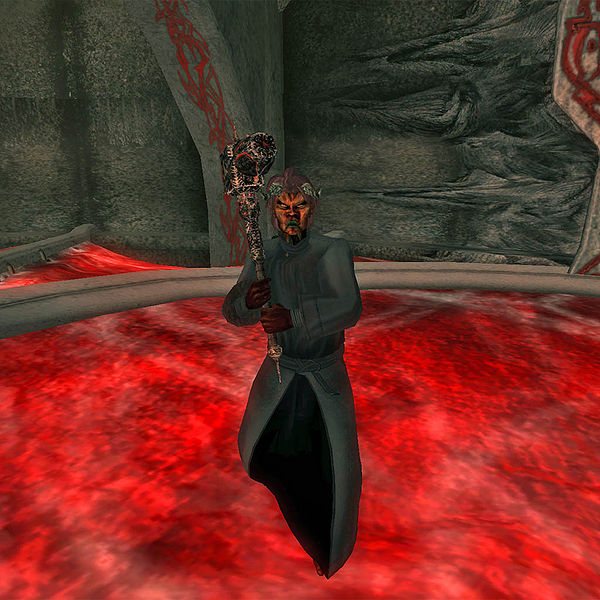
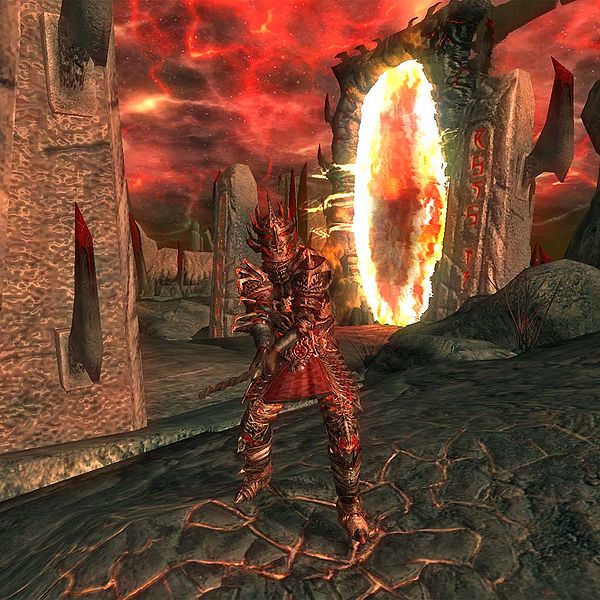
The Dremora are basically the main sentient race of Daedra that live in Oblivion, and tend to play the role of commanders and overseers in the ranks of Mehrunes Dagon's forces (that's the name of the big Daedra Prince that serves as the final threat of the story). And the Dremora are basically a fair bit more... ugly compared to their Skyrim versions, but I do enjoy both portrayals of the Dremora. Oblivion's Dremora have far more pockmarked and disfigured faces -- partially caused by the limitations of the Oblivion engine -- as well as demonic horns. They exist in basically as many variations of classes as other NPC's in the game do.
Also, while I placed the Dremora at the very end of the "generic" Daedra from the vanilla game, the Dremora's power levels vary extremely highly, with the weakest among them being barely stronger than Scamps, while the strongest ones among them able to give any given enemy in the game a run for their money. This is displayed in game by different power levels of Dremora having different ranks depending on their caste -- which, in order, are Churl, Caitiff, Kynval, Kynreeve, Kynmarcher, Markynaz and Valkynaz. And the common syllable in the stronger variants of the Dreamora is "Kyn", which is the Dremora's word for their own people, sort of equivalent to the English language's usage of the word "men". Like, y'know, fire-men, police-men and the sort.
Anyway, they make for pretty decent demonic antagonists. I do sometimes wish that the Dremora's voice acting was just a wee bit less scratchy than what they actually got, though.
Siege Crawler
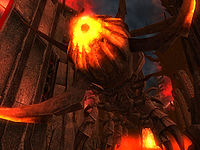
The Siege Crawler is a one-time boss that most Oblivion players remember for being a huge part of the opening cinematic. One of the final quests of the main storyline involves you going into a Great Oblivion Gate and stop the Siege Crawler from blowing up a city, though, and... and it's neat to see that the Dremora rely more than just brute force and numbers to crush humanity. The Siege Crawler's a pretty neat being, too. In addition to that gigantic cannon-drill thing prominently displayed in that image, it's a gigantic horizontal column with loads and loads of centipede-like legs that slowly crawl and move around. What is it about demonic forces in fantasy setting often associated with sentient infernal machinery? I guess machinery in and of itself sort of play into the sheer unnatural-ness that we tend to associate with demons, huh?
Anyway, I appreciate that there's at least a couple of unique bosses in Oblivion, even if the Siege Crawler isn't an enemy you'll actually physically fight. I mean, you can, but you'll just be killed.
Mehrunes Dagon

Mehrunes Dagon is the main antagonist of the game, although he doesn't really show up until like the eleventh hour. For a good chunk of the game you contend with the leader of the cult worshiping him, Mankar Camoran, who actually does have a personality and monologue a fair bit. That, or an Easter Egg hunt throughout Cyrodiil to find magical items for the rituals needed to stop Dagon. Of course, as with any given giant force of destruction, Mehrunes Dagon will eventually show up and lay waste to a part of the Imperial City. He ends up being more of a piece of scenery that can damage you than anything, though, since you don't fight him so much as run away and try to set up a trap to defeat him via cinematic.
And... and I guess his design works as an arch-demon? It's simple enough to work off of the same humanoid skeleton that a vast majority of Oblivion's enemies work off of, and having four arms just makes him distinct enough from the run-of-the-mill Dremora or Xivilai. I just don't find him super-impressive, but at least he looks distinct. That, and that he's like Godzilla-sized when he walks around in the Imperial City.
Auroran
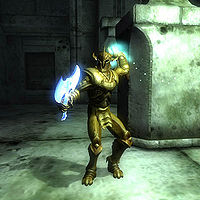
I'm going to briefly cover the new sort of enemy added in the "Knights of the Nine" DLC, which involves your character travelling to re-assemble an ancient holy set of armour, while fending off Daedric servants of a reincarnated immortal Ayleid-elf warlord, Umaril. Umaril struck a bargain with Meridia, the Daedric Prince of light and life, to make himself immortal, and while Meridia herself remains neutral in the conflict, she does lend her minions, the Aurorans, to help out in the crusade.
As such, the Aurorans are... interesting beings, technically Daedra but looking pretty 'holy'. They're basically golden suits of armour wielding giant axes, and they're pretty neat! Not a particularly novel enemy concept, but they're pleasant looking for what they are, and definitely look pretty different from most of what we see in Oblivion.
Umaril, the Unfeathered
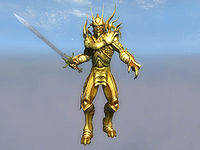
Umaril the Unfeathered himself is sort of just the same model with Aurorans, only he has a unique helmet and a whole ton of spikes jutting out of his shoulders. He doesn't actually say much, and in Elder Scroll Main Villain fashion tends to stay offscreen and only known from other NPC's and in-game books describing him. The history of Umaril is pretty neat, though, and I do appreciate the journey that it took to defeat him -- especially the particularly memorable bit where after slaying his physical body, you go to a plane in the skies, like heaven or some shit, to put down his immortal soul permanently.
Again, though, shame that he doesn't really have that much of a personality beyond "rawr ancient evil out for vengeance". I'll always remember him for the sheer ridiculousness of his title being "Unfeathered", though. No, Umaril isn't some Destroyer or World-Eater or Souldrinker or any old main villain title. He's the Unfeathered.
And with this Unfeathered villain, I'm going to close this particular article. I don't really end up talking too much about these as I thought I would -- the Daedra of Oblivion fall into a ball of neat, safe designs for the most part. And that's honestly what I really feel about Oblivion as a whole -- up until the Shivering Isles, it just feels so much like the designers are just playing it safe. Nothing about it is particularly bad or problematic (relatively speaking), but not a lot of it really feel like they're just including the most basic versions of any given fantasy monster enemy.
No comments:
Post a Comment